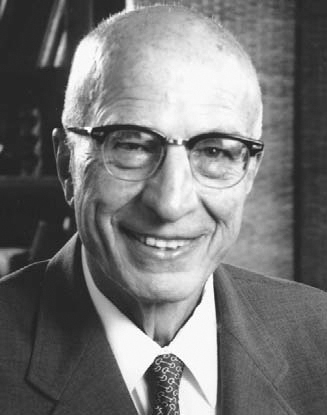Harry George Drickamer
DOI: 10.1063/1.1522182
Harry George Drickamer, a pioneer in high-pressure studies of condensed matter and a professor of chemical engineering, chemistry, and physics at the University of Illinois for 56 years, died of a stroke on 6 May 2002 in Urbana, Illinois.
Harry was born on 19 November 1918 in Cleveland, Ohio. After graduating from high school early, he played professional baseball in the Cleveland Indians minor league farm system. He attended Vanderbilt University on a football scholarship and then Indiana University. He then transferred to the University of Michigan, where he received a BS in chemical engineering in 1941 and was president of his engineering college class. In 1942, he received his MS degree in chemical engineering from Michigan.
During World War II, Harry worked for Pan American Refining Corp in Texas City, Texas, as a chemical engineer. Just before leaving for this job, he took and passed the PhD qualifying exam in chemical engineering. In Texas, in addition to his regular duties, Harry was busy nights and Sundays collecting experimental data that he presented for his PhD thesis after the end of the war. He received his PhD in chemical engineering from Michigan in 1946. His thesis, entitled “Vapor–Liquid Equilibria in Phenol–Hydrocarbon Systems and Their Application to a Conventional Toluene Unit,” was prepared under the guidance of George Brown and Robert White.
That same year, Harry joined the University of Illinois at Urbana-Champaign. He became a member of both the chemistry and chemical engineering departments in recognition of the breadth of his research. He was later also appointed a professor of physics. In 1963, he was made Professor in the Center of Advanced Study, the highest recognition the university bestows on members of its faculty.
Fifty years ago, Harry conceived the idea that pressure should be a powerful tool for investigating electronic phenomena in condensed phases. The main theme of his work was the concept that pressure can change the properties of condensed matter systems by its effect on the electronic orbitals—a phenomenon he called “pressure tuning” of electronic orbitals. The electrical, optical, magnetic, and chemical properties of solids or fluids depend on the relative energies of the electronic orbitals associated with the ground and excited states of the outer electrons belonging to the atoms or molecules. The effect of pressure is to decrease the volume and thus increase the overlap among the electronic orbitals. Because different orbitals have different radial extent and shape, they are perturbed to different degrees.
Harry showed that the use of pressure gave a powerful and versatile approach to the investigation of electronic phenomena. His concept of pressure tuning has proved to be a tool of great power and versatility and is now used by many research groups worldwide.
Harry provided clear-cut tests for the following theories: the ligand field theory (in the 1950s and 1960s); Van Vleck’s theory of high-spin to low-spin transitions (1960s and 1970s); Forster–Dexter theory of energy transfer in phosphors (late 1970s); and Mulliken’s theory of electron donor–acceptor complexes (1970s and 1980s). During the 1980s, he also developed successful tests for theories of the efficiency of a variety of phosphors and laser materials including II–VI and III–V compounds that exhibit the zincblende structure, rare earth oxides, chelates, and organic phosphors.
Starting in the late 1950s, he observed electronic transitions, including insulator–conductor transitions for six elements and about 30 compounds and transitions involving the conduction electrons in alkali, alkaline earth, and rare earth metals. He also observed paramagnetic–diamagnetic and ferromagnetic–paramagnetic transitions in ferrous compounds and in iron during the 1970s. In addition, he noticed that radicals were formed in many electron donor–acceptor complexes with high pressure and found that those radicals reacted to form new chemical bonds. Photochromic materials became thermochromic at high pressure. From the 1980s until before he died, Harry’s research expanded to protein chemistry, the efficiency of luminescent devices, and organic photochemistry.
Among the 27 major awards Harry received were the Oliver E. Buckley Prize in Condensed Matter Physics (1967) from the American Physical Society, the Irving Langmuir Award in Chemical Physics (1974) from the American Chemical Society, and the P. W. Bridgman Award (1977) from the International Association for the Advancement of High Pressure Science and Technology. In 1989, President George H. W. Bush awarded him the National Medal of Science, and he received an honorary doctorate in 1994 from the Russian Academy of Sciences. The remarkable nature of his work is brought out by the fact that these honors were based both on research and teaching and are from organizations in physics, chemistry, and engineering.
Harry guided more than 100 doctoral students and 20 postdoctoral students. His retirement in 1989 did not change his research schedule; he continued to maintain an active research group and was in his laboratory six days a week. In 1995, Harry’s former students contributed money for a professorship in his honor, but, as was typical of him, he decided it should be used to help graduate students. Drickamer Fellowships were instituted in the departments of chemical engineering, chemistry, and physics at the University of Illinois. Harry is sorely missed by his family, friends, and colleagues in the US and abroad.

Harry George Drickamer

More about the Authors
Jiri Jonas. University of Illinois, Urbana-Champaign, US .
Charles Slichter. University of Illinois, Urbana-Champaign, US .
